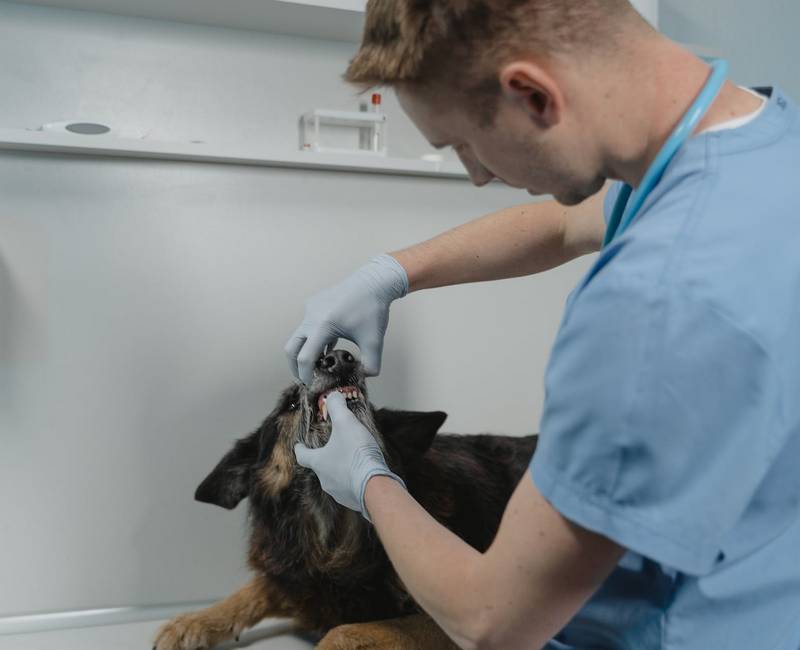Do Vets Know How to Handle Aggressive Dogs? (+How to Prep!)
Do vets know how to handle aggressive dogs? Is your dog scared of the vet? In this article, we’ll fill you in on how vets deal with aggressive dogs to ensure that they stay safe and get the care they need. We’ll also cover why some dogs become fearful or aggressive at the vet and what you can do to alleviate their anxiety, including using the “Quiet” command.
We’ll provide tips on how to prepare for a vet visit with an aggressive dog, from making them comfortable with the environment to knowing what to expect if your dog exhibits aggressive behavior, like barking or freaking out. We’ll also discuss what happens in scenarios where a dog might bite the vet. Keep reading!
Do Vets Know How to Handle Aggressive Dogs?

Vets do know how to handle aggressive dogs. Veterinarians are trained to handle a variety of animal behaviors, including aggression in dogs. They employ techniques and precautions to ensure the safety of both the animal and the medical staff.
How Do Vets Deal With Aggressive Dogs?
Veterinarians and their staff use a combination of approaches to manage aggressive dogs. These can range from simple distraction and calming techniques, all the way to using muzzles or sedatives in more severe cases. They also rely on body language reading and non-threatening behavior to reduce the dog’s anxiety.
In some cases, vets might suggest behavioral training or modifications to address the root cause of aggression.
Dog Barks at Vet: How to Stop
Training your dog to respond to the “quiet” command can be beneficial for visits to the vet.
- Begin by allowing your dog to bark, then calmly say “quiet.”
- When your dog stops barking, even for a moment, immediately reward them with a treat or praise.
- Practice this regularly, gradually increasing the duration of silence before rewarding.
This command helps manage your dog’s barking and reduces stress during veterinary visits.
How to Take an Aggressive Dog to the Vet
Taking an aggressive dog to the vet requires preparation and caution. Inform the veterinary staff ahead of time about your dog’s behavior. Use a muzzle if necessary, and ensure your dog is securely leashed.
Consider visiting the vet during less busy hours to reduce stress and distractions. Working with a professional trainer or behaviorist can also help in preparing your dog for vet visits.
Veterinarians know how to handle aggressive dogs, and they do so by employing various strategies to ensure a safe and stress-free environment. Training your dog to respond to commands and preparing adequately for vet visits can significantly aid in managing an aggressive dog’s behavior.
It’s important to remember, however, that the underlying behavioral issues (anxiety, fear, aggression, etc.) that were causing all of this to begin with will still be present. And until you address those, any positive changes you see will only be temporary.
“Well, how do I make these changes last?”
By getting your dog to truly choose to follow your direction, that’s how. I tried many times to write out how you can do that before deciding it made more sense to just link you to the free video series that explains it better than I’d ever be able to.
The series is by a man named Dan who is one of the world’s leading dog obedience trainers. In it, he teaches you how to put an end to things like your dog barking at the vet and all other misbehavior using his fast and easy-to-follow methods.
In the first video, Dan will reveal to you why the two most common methods of dog training only doom you to failure. You can watch the video now by clicking here. Follow the proven system he’ll show you in his series and you’ll never have to spend another second worrying about your dog getting aggressive with the vet ever again!
Why Are Dogs Scared of the Vet?

Dogs are scared of the vet due to a variety of reasons, including unfamiliar environments, strange smells, previous negative experiences, and the anticipation of discomfort. These factors can make veterinary visits stressful for dogs, as they associate the vet with anxiety and fear.
Dog Freaks Out at Vet
When a dog freaks out at the vet, it’s often a response to fear and anxiety. This behavior can manifest as excessive barking and growling, shaking, or trying to escape. These reactions are typically due to the unfamiliarity and stress associated with the vet’s office, including unfamiliar people, unfamiliar animals, other dogs, and the memory of past experiences.
Learn how to take an aggressive dog to the vet without it being a complete nightmare by going back to the first section now.
Dog Won’t Let Vet Examine Him
A dog refusing to let the vet examine him is a common issue rooted in fear and mistrust. To address this, gradual desensitization and positive reinforcement can help. This involves slowly getting the dog accustomed to being handled and associating vet-like touches with positive experiences, such as treats and praise.
What Happens if My Dog Bites the Vet?
If a dog bites the vet, it’s typically treated as a serious incident. The vet might implement additional safety measures for future visits, such as muzzling. You need to inform the vet about your dog’s aggressive tendencies beforehand. In some cases, behavioral training may be recommended to prevent future incidents.
In conclusion, having a dog afraid of the vet is a common issue that often results from negative associations and unfamiliarity. Understanding the root of this fear and working towards creating positive experiences can greatly reduce anxiety during vet visits.
Gradual desensitization, positive reinforcement, and clear communication with the vet are key steps in helping a dog overcome fear of veterinary visits.
I’m sure you’re ready to begin now that you have all of your questions about vets and aggressive dogs answered, so I’ll let you get started on things. Good luck, and thanks for taking a look at our article “Do Vets Know How to Handle Aggressive Dogs?”.





